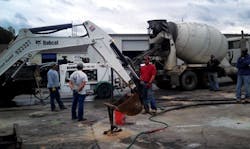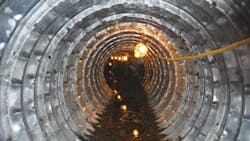How to Rehabilitate a Culvert
Lake City, in Clayton County, Ga., is part of the Atlanta metro core. In recent years, new construction has overgrown some existing underground assets, complicating rehabilitation of existing infrastructure.
In one case, a 66-in., 20-ft deep, 220-ft long corrugated metal pipe (CMP) culvert was failing so dramatically that parking lots and commercial buildings overhead were subsiding noticeably and had to be monitored throughout subsequent rehabilitation.
Inspection revealed inverts that were completely corroded, sidewalls that were curling up into the pipe interior and some collapsed pipe. After this discovery, the failure accelerated.
“From quote to award, the culvert had collapsed even further,” said Anita Clyne, president of Utility Asset Management Co. (UAMC). “That’s when we realized typical procedures would not be enough for this project.”
“It wasn’t a surprise,” said Terry Moy, P.E., M.ASCE, manager of program management and engineering for the Clayton County Water Authority (CCWA). “We’d identified it for rehabilitation a year before and were in the process of working through access and business impacts with the property owners, but increased storm runoff accelerated the migration of the backfill around the pipe. This eliminated the possibility of a cured-in-place solution.”
Surprise or not, it was very nearly a worst-case scenario for culvert rehabilitation. The CMP no longer reliably supported overhead soil, so simply being in the pipe was unsafe. There were active commercial buildings directly over the culvert, so trenching was out of the question. And culvert capacity could not be reduced significantly, according to CCWA engineers, which ruled out sliplining and other minimally invasive procedures.
A three-phase solution was implemented to safely rehabilitate this critical piece of storm water infrastructure, without significant capacity reduction and without disrupting overhead businesses.
To prevent soil instability, the team stabilized the surrounding soil with cementitious grout.
Phase One: Stabilize the Culvert
In phase one, 54-in. tunnel liner plates were used to structurally stabilize the culvert. These four- part, 18-in.-wide steel rings were assembled within the pipe.
“First, we had to cut out curled-in pieces of the old culvert by hand,” Clyne said. “Then we assembled the liner plates inside the culvert, section-by-section—basically, we were building a new pipe, 18 in. at a time. And meanwhile, cars and trucks were driving by in the parking lot above us.”
The liner plates’ four arched sections were bolted together manually, and each completed section created a new 18-in. safe zone for workers, who then repeated the process 146 times. After the new “tunnel” was completed, the void between the liner plates and the existing 66-in. CMP was filled with injected grout. It was tedious work in a cramped space, but it was safe and effective; phase one was completed with no injuries and no further subsidence of overhead buildings, and the culvert was stable.
Phase Two: Create a Smooth Lining
Phase two involved creating a smooth, watertight, structurally sound pipe within the new tunnel liner plates, and smoothing out the corrugations created by flanges. For this phase, UAMC used CentriPipe, a trenchless repair technology with which they previously had success. Developed by AP/M Permaform, the centrifugally cast concrete pipe (CCCP) technology relies on a computer-controlled spincaster inserted into round, large-diameter pipes, and sprays thin layers of fine aggregate composite concrete as it is pulled back through the pipe at precisely calculated speeds.
In the Forest Parkway project, UAMC began by hand troweling grout to fill in flange gaps and create a smooth invert so the spincaster could be pulled back without jerking. An engineered, 1-in. thickness of PL-8000 material was then applied, completing the culvert rehabilitation.
The lining system created a new concrete pipe within the new tunnel liner plates. Since both are structurally sound and the PL-8000 adheres to steel, the combination of tunnel plates and new pipe is exceptionally sturdy and will last indefinitely, even while subject to the heavy loads of a commercial center.
In phase one, 54-in. tunnel liner plates were used to structurally stabilize the culvert.
Phase Three: Soil Stabilization
The third and final phase involved addressing the cause of the dramatic failure: the extremely unstable soil surrounding the pipe. To prevent similar problems for the rehabilitated culvert, CCWA called for stabilization of the surrounding soil with cementitious grout, which was injected until refusal.
To ensure quality, CCWA had very tight project specifications, applied normal inspection procedures, and contracted with an independent geotechnical firm for onsite representatives. The completed project is performing well, and Terry Moy, P.E., M.ASCE., manager of program management for CCWA, is pleased with the results.
“I’m an active member of the Pipeline Div. of the American Society of Civil Engineers,” Moy said. “And centrifugally cast pipe is proving to be a viable solution. Together with the tunnel plates and grout injection, it was certainly effective for us.”


